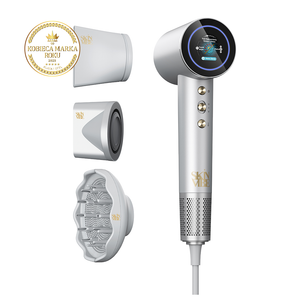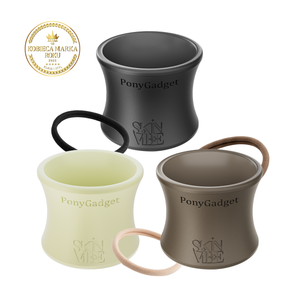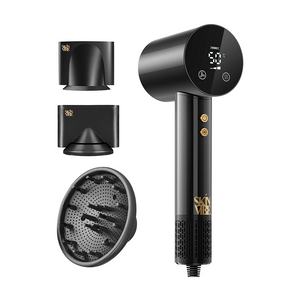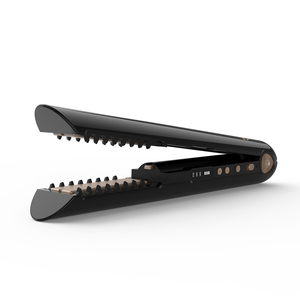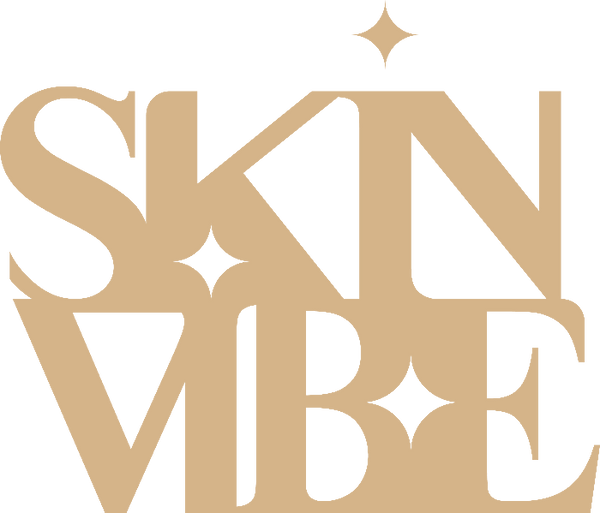How to Dry Your Hair Properly: Proven Ways to Keep Your Hair Healthy and Shiny
Did you know that wet hair is most susceptible to damage? When hair absorbs water, its cuticles open, increasing its volume and exposing it to damage. Therefore, the question "how to dry hair properly" becomes crucial to maintaining its health and beautiful appearance.
The truth is that blow-drying your hair isn't the most kind solution if done incorrectly. However, if you follow the right technique - keeping the dryer at least 30 cm away from your head and using the right temperature - you can significantly minimize the risk of damage and enjoy healthy, shiny hair.
In this guide, we'll show you how to properly dry your hair to maintain its natural structure and beautiful appearance, regardless of your hair type and desired styling effect.

The Effect of Drying on Hair Health
Hair structure is a complex system of natural protective mechanisms that help maintain hair health and shine. Understanding this structure will help you take better care of your hair during your daily care routine.
Natural protective mechanisms of hair
Each hair has a protective layer of scales that protect its core from damage. These scales, when properly closed, create a natural protective shield that prevents moisture loss and protects against external factors.
Hair also has a natural protective barrier in the form of intercellular cement, which contains valuable polysaccharides and lipids. This layer is responsible for the elasticity and flexibility of hair.
When washing hair with warm water, the scales open and the hair swells and becomes heavier. This is a natural process, but requires a proper approach when drying so as not to damage this delicate structure.
When drying is harmful
Improper drying can lead to serious hair damage. Common mistakes to avoid include:
- Hot air drying immediately after washing
- Holding the dryer too close to your head (less than 20-30 cm)
- Concentrating the air flow in one place for a longer period of time
- Drying wet hair without first draining excess water
- Too high temperature during the entire drying process
Too high a temperature during drying can cause the hair cuticle to shrink and crack, while the cortex does not shrink as quickly. As a result, this leads to damage to the hair structure and its breakage.
Interestingly, leaving your hair to dry naturally isn’t always the best solution either. The longer your hair stays wet, the greater the risk of polysaccharides and lipids breaking down. Additionally, a wet scalp creates the perfect environment for bacteria and yeast to grow, which can lead to skin problems.
Sleeping with wet hair is particularly dangerous - during sleep, the hair is exposed to friction against the pillow, which, given its increased elasticity, can lead to mechanical damage.

Choosing the Right Dryer
When choosing a hair dryer, pay attention to its technical parameters, which have a key impact on the health of your hair. The right device will not only speed up the drying process, but also take care of the condition of the strands.
Key technical parameters
The power of the dryer is one of the parameters that affects the speed of drying. Modern technologies mean that dryers with a power of 1500-1600W offer optimal performance in everyday home use, ensuring fast and effective drying for all hair types. It is worth remembering that for the health of hair, the quality of the technology used in the device is more important than raw power - such as ionization or innovative plasma technology , which significantly increase the efficiency of drying while maintaining hair safety.
Modern dryers offer the following key features:
- Plasma Technology - a cutting-edge solution that generates both positive and negative ions, closing hair cuticles, eliminating static and giving exceptional shine (available in the SkinVibe Aurea Family x Plasma dryer)
- Ionization - emits negative ions that close hair cuticles, giving shine and preventing electrification
- Temperature and airflow adjustment - allows you to adjust the parameters to your hair type
- Cold air - closes hair cuticles, fixes the hairstyle and adds shine
In the case of motors, the most durable are models with an AC motor (up to 2,000 operating hours) and brushless ones, which work up to 10,000 hours.
Types of tips and their uses
A professional dryer should be equipped with appropriate attachments that increase its functionality:
- Two Types of Concentrators - High-quality dryers often offer both a basic concentrator for everyday use and a professional concentrator with a narrower gap for even more precise styling and straightening.
- Diffuser - a necessary tip for curly and wavy hair. It is worth noting that wavy diffusers significantly outperform traditional flat models in terms of effectiveness. The wavy design disperses air better, emphasizes natural curls more precisely and increases the volume of the hairstyle more effectively. The diffuser's protrusions additionally massage the scalp, improving microcirculation.
Also remember to regularly clean the air filter, which protects the engine from dirt. This ensures a longer life for the device and its efficient operation.

Professional Modeling Methods
Professional hair styling begins with proper preparation. The right drying technique not only protects hair from damage, but also helps achieve the desired effect.
Root Lifting Technique
To achieve a lifting effect at the roots:
- Blow dry your hair until it is about 80% dry
- Divide the hair into sections using hair clips
- Direct the blower from the top down at the base, using slightly warmer air.
- Use a cooler airflow on long lengths
- For maximum lift, lift a section of hair and direct warm air at the root from underneath.
How to get a smooth finish
The key to achieving a smooth finish is:
- Using a concentrator (a narrow tip that fits over the dryer nozzle)
- Always dry your hair in one direction, preferably in the direction of hair growth.
- Keep the dryer at least 30 cm away from the scalp
- Using a large round brush to roll up the strands while drying
- Finish with a cool blast that seals the hair cuticles
Tricks for more volume
Professional hairdressers use several proven methods to increase volume:
- Roll your hair around the round brush from the roots to the ends, directing the airflow of the dryer towards the hair on the brush
- Use a diffuser with nubs, pressing it gently against your head while drying with a cooler airflow
- Use volumizing mousse on slightly damp hair before styling.
- Dry your hair with your head slightly tilted, directing the airflow from the bottom upwards (this technique should be used briefly to avoid frizz)
Remember to avoid holding the dryer in one place for too long while styling, this prevents overheating of the scalp and hair. If the hair becomes too hot during styling, use a comb and let it cool down, gently combing.

Solving Common Problems
Blow-drying hair problems can be frustrating, but with the right approach, they can be effectively resolved. Learn proven methods for dealing with the most common challenges.
How to deal with frizzy hair
Frizzy hair is often the result of improper care and weather conditions. Highly porous hair is most susceptible to frizz due to its open cuticles.
Effective solutions include:
- Using cold air at the end of drying
- Using products with keratin and silk
- Regular application of moisturizing masks
- Drying hair in the direction of growth
- Using plasma technology dryers that significantly reduce frizz
First of all, take care of proper hydration - well-hydrated hair is naturally weighed down, which reduces the tendency to frizz.
Method for electrification
Hair static electricity occurs when too many positive ions accumulate on the strands. The problem is usually worse in the fall and winter, when dry air conducts electrical charges more easily.
To effectively prevent electrification:
- Use a hair dryer with an ionization function or plasma technology
- Use two-phase leave-in conditioners
- Avoid combing frequently while drying
- Invest in cosmetics containing moisturizing ingredients such as Betaine or Behetrimonium Chloride
- Keep the drying temperature low, especially towards the end of the process
Fighting against tangled locks
Tangled hair is a problem that particularly affects people with high porosity and damaged hair. Hair tangles the most when it is wet - then it is most susceptible to mechanical damage.
To minimize tangling:
- Comb your hair before washing it
- Use mild shampoos without SLS
- Rinse cosmetics thoroughly
- Gently blot excess water with a towel instead of rubbing vigorously.
- Use products containing silicones and emollients that effectively prevent hair from tangling.
- Dry your hair by directing the airflow from top to bottom, in the direction of the hair cuticles.

Care After Drying
After drying the hair, the key stage of care begins, which determines its long-term appearance and condition. Proper protection and care after drying ensures that the hair looks healthy and has a natural shine.
Natural ways to shine
The basis of shiny hair is its proper hydration and nourishment. Natural oils are an effective method to restore hair's shine:
- Argan oil - perfect for all hair types
- Jojoba oil - perfectly moisturizes without weighing down
- Apricot oil - regenerates dry hair
- Plum seed oil - adds shine without weighing down
The natural shine of hair is the result of light reflecting off the smooth surface of the hair. That is why it is so important to use products that smooth the hair cuticles.
An effective way to achieve the surface effect is an apple cider vinegar rinse, which stabilizes the pH of the scalp and protects the hair from the harmful effects of hard water. Additionally, rinses with an acidic pH close the hair cuticles, giving them smoothness and shine.
Tip protection
The ends of hair require special care because they are most susceptible to mechanical and thermal damage. First of all, regular protection of the ends reduces the problem of breakage and crumbling, which is especially important for people who want to grow their hair.
Effective tip protection is based on several key elements:
- Applying serum or oils to the ends - they create a protective barrier
- Regular application of nourishing masks - strengthens the hair structure
- Using heat protection products before every blow-dry
- Using leave-in conditioners on hair ends
It is worth remembering to protect against external factors. Even in changeable weather, use special protective products that will protect your hair from moisture and the harmful effects of the sun.
Emollient care, which involves regular use of natural oils and masks, is particularly effective. Additionally, hair that tends to frizz responds well to products containing silicones, which create a protective coating on the hair.

Conclusions
Proper hair drying is the foundation of a healthy and beautiful hairstyle. First of all, the right drying technique protects the hair structure, prevents damage and helps maintain natural moisture.
The right tools and care products play a key role in the styling process. If you are looking for professional hair equipment, check out the dryers available at skinvibe.pl - you will find there an innovative dryer with plasma technology SkinVibe Aurea Family x Plasma , which not only speeds up the drying process, but also actively cares for the health of the hair.
Remember that healthy and shiny hair is the result of systematic care. Additionally, using the right drying temperature, styling tips and protective products significantly affects the condition of your hair.
Regular aftercare, proper protection of the ends and the use of natural methods for shine will make your hair look professional every day. Well-groomed hair is not only a matter of the right equipment - it is a combination of the right technique, high-quality cosmetics and systematic care.
Frequently Asked Questions
How to dry your hair properly to keep it healthy?
The healthiest way to dry your hair is to direct the airflow from the roots to the ends, in the direction of hair growth. You should constantly move the dryer, avoiding focusing on one spot for too long. It is also important to keep the dryer at a suitable distance from the hair (minimum 30 cm) and use a cooler airflow on the ends.
What are the best practices to avoid damaging your hair when blow-drying?
To minimise damage, always apply a heat protectant before blow-drying, gently pat dry excess water with a towel before using a hair dryer, use the appropriate temperature (lower on the ends), use the ion function or plasma technology and finish drying with a cool shot.
Is drying your hair upside down recommended?
Drying your hair upside down can add volume to your hair, but this method should be used sparingly and sparingly, as it can cause frizz. A better solution is to use the root lift technique with a round brush and dry your hair in a natural position.
How to prepare your hair for drying?
Before drying, gently blot excess water with a towel, avoiding vigorous rubbing. Then apply a heat protectant to all hair, paying special attention to the ends. If necessary, gently comb the hair with a wide-toothed comb, starting from the ends and gradually moving upwards.
What are the most effective methods for making hair shiny after blow-drying?
To achieve shine after blow-drying, finish the process with a cool shot, which closes the hair cuticles. Apply natural oils (such as argan or jojoba) to dry ends, use hydrating masks regularly, and consider apple cider vinegar rinses, which stabilize pH and add shine. A blow-dryer with plasma technology , which balances positive and negative ions, also significantly improves hair shine.


